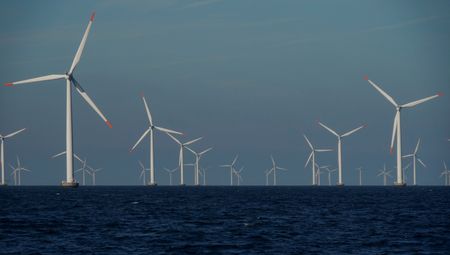By Nora Buli and Stine Jacobsen
OSLO/COPENHAGEN (Reuters) – Denmark’s failure to attract any bids in an offshore wind power tender this week stems from a rigid auction model, a failure to adapt to a changed economic reality for renewable energy projects and rising competition, analysts said on Friday.
The outcome was a blow to Denmark, home to turbine maker Vestas and offshore wind developer Orsted, which has been a pioneer in onshore and offshore wind power.
The tender for at least 3 gigawatts (GW) of capacity in the Danish North Sea offered no subsidies, instead inviting competition for payments over 30 years to the state, which would also own a 20% stake in each of the tendered projects.
“The way the auction design is made reflects the past market and not the current costs of building offshore wind,” said Soren Lassen, head of global offshore wind research at Wood Mackenzie.
Instead of taking from developers, the Danish government should consider what they can provide them with, he added.
The Danish system does not offer any subsidies or revenue stabilisation which makes it less attractive for developers compared to similar offshore wind auctions in Poland, the Netherlands and Britain, industry lobby group WindEurope said.
“Denmark’s uncapped negative bidding creates an unhealthy race to the bottom and unnecessarily increases the upfront costs for offshore wind developers,” WindEurope said in a statement.
In addition, Denmark does not pay for the costly grid connection to the offshore wind farms.
Denmark’s Climate and Energy Minister Lars Aagard told Reuters that the conditions for the tender were agreed at a time when market conditions were much more favourable, paving the way to build wind farms at sea with no subsidies.
In 2021, Denmark’s tender for the 1 GW Thor wind farm was so hotly contested by developers willing to pay for the rights, it was decided in a lottery won by Germany’s RWE.
However, over the past three years, the offshore wind industry has been hit by surging costs, rising interest rates and supply chain bottlenecks.
“They are challenged on both the cost side and the revenue side,” Aagard said.
Developers also faced uncertain electricity prices.
“We have an electricity system that has a lot of renewable energy,” said Brian Vad Mathiesen, professor in energy planning and renewable energy systems at Aalborg University.
“In order to increase that amount you have to redesign consumption patterns,” he added.
Using excess power generated by wind at times when it is not needed by users to produce so-called green hydrogen is one potential solution to the problem, but development has stalled.
Denmark’s latest tender is part of a wider political agreement to install at least 6 GW of new offshore wind capacity by 2030, and making adjustments ahead of further tenders will be complicated, said Rikke Noergaard, chief commercial officer at analysis firm Aegir Insights.
However, a potential delay to the Danish plans may not be all negative, she added.
“Just looking at the big developers’ pipeline, most of them filled up their pipeline until 2030, but there’s a lot of room after 2030,” Noergaard said.
(Reporting by Nora Buli in Oslo and Stine Jacobsen in Copenhagen; Editing by Alexander Smith)
